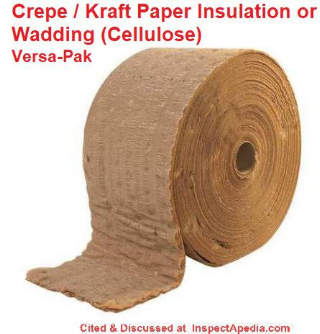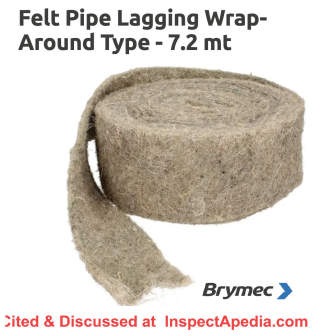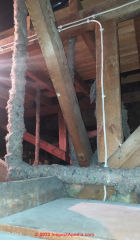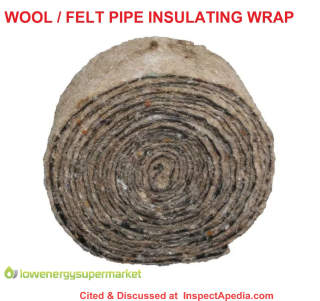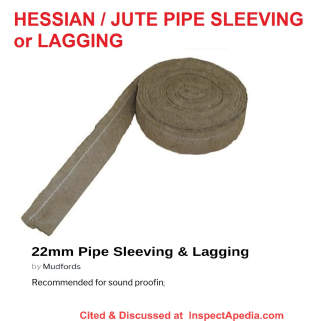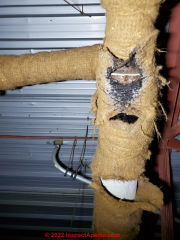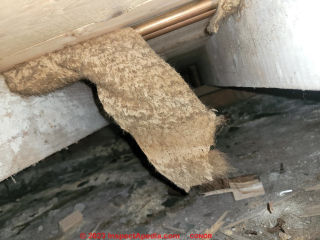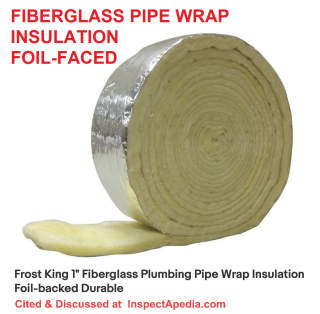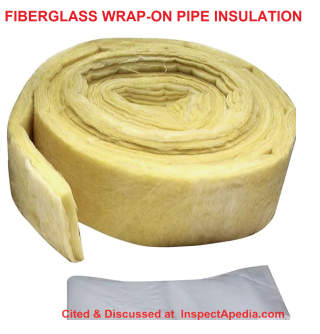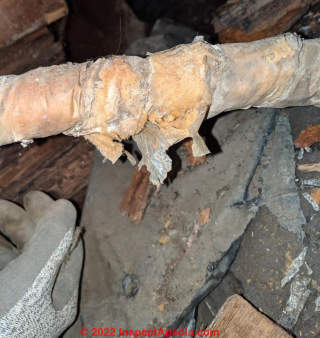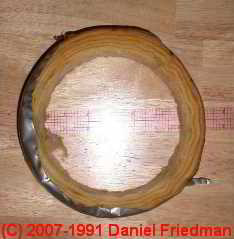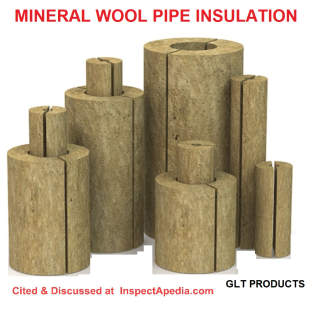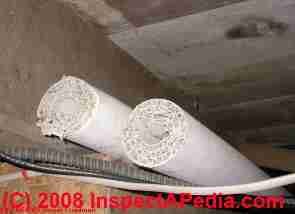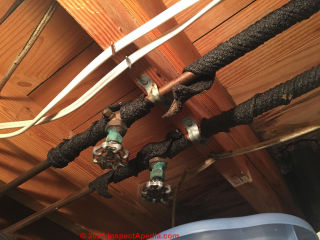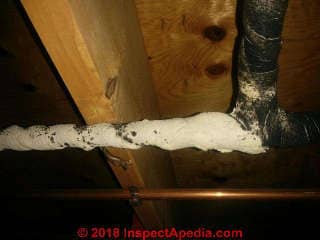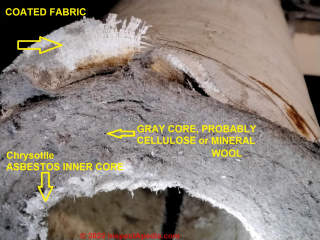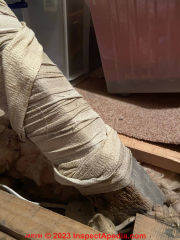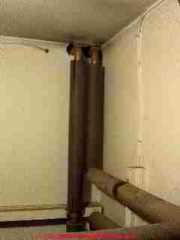 Insulate to Prevent Frozen Pipes
Insulate to Prevent Frozen Pipes
+ Identify Types of Pipe Insulation
- POST a QUESTION or COMMENT about how to add and identify pipe insulation or in some cases building insulation and draft-stopping materials at cold problem spots to avoid freezing pipes.
Pipe freeze-protection for buildings: advice for adding pipe insulation to reduce the risk of freezing is followed by an assessment of how well insulation alone can work to prevent frozen pipes. We include a catalog of types of pipe insulation use in and around buildings.
The articles in this series will answer most questions about freeze protection for piping and other building plumbing and heating system components: how to winterize a building to avoid frozen pipes, and how to thaw frozen water supply & drain piping, wells, & water tanks, heating system piping and heating oil piping.
InspectAPedia tolerates no conflicts of interest. We have no relationship with advertisers, products, or services discussed at this website.
- Daniel Friedman, Publisher/Editor/Author - See WHO ARE WE?
Pipe Insulation to Prevent Freezing
 We suggest adding pipe insulation or in some cases building insulation and draft-stopping materials at cold problem spots to avoid freezing pipes.
We suggest adding pipe insulation or in some cases building insulation and draft-stopping materials at cold problem spots to avoid freezing pipes.
But as you'll read, that's not the whole story. Even well insulated pipes can freeze when not in use and where exposed to prolonged freezing temperatures.
Article Contents:
- ADD WATER PIPE INSULATION
- CAN INSULATION PREVENT FROZEN PIPES?
- PIPE INSULATION CHOICES, MATERIALS, TYPES, IDENTIFICATION PHOTOS
Add Water Pipe insulation to prevent freezing:
Insulation can be added to protect pipes routed through unheated areas or near cold building corners. We particularly like to add slip-on foam pipe insulation where a plumbing line is run past a cold spot that is hard to warm up.
Some writers believe that if you insulate all of your water supply piping you won't have a frozen pipe problem.
That may be a bit optimistic: we fear that a cold corner somewhere will be missed and left uninsulated, or that a house left without heat for too long will get cold enough to freeze even an insulated pipe.
The advantage of insulating pipes is that it slows the rate at which a water pipe will freeze, possibly getting the pipe through the coldest part of the night and into a (hopefully) warmer daytime to warm up again.
Remember, when insulating a water pipe, that you need to insulate all of it. Don't leave those awkward elbows or pipe tees uninsulated.
...
Does Insulation Prevent Pipe Freezing in Prolonged Cold Periods? Probably Not.
Watch out: Here is a speculative warning about relying on pipe insulation alone to avoid freezing, that is, we don't have hard science to back up this opinion:
Insulation on a water pipe will often protect building supply or drain pipes, unused heating pipes & heating oil lines from freezing during a brief spell of freezing temperatures.
But during a period of prolonged very cold nights and only moderately warmer days, we are not so sure that the insulation permits the pipes to accumulate "cold" rather than warmth. When this is the case, ultimately the pipes reach the freezing point.
Plastic piping to resist freezing:
Modern plastic piping is considerably more tolerant of freezing without bursting than copper or steel water pipes. In a home intended for regular winterization, some builders use exclusively plastic pipes to resist freeze damage.
Watch out: even when freeze-tolerant piping is used, the piping connections, elbows, unions, couplings, and plumbing fixtures are still at risk of frost damage.
...
Identify Common Pipe Insulating Materials
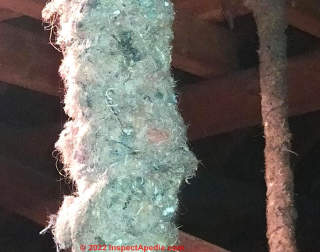 Below we provide a complete guide to different kinds of pipe insulating materials including common and modern products as well as photographs and properties of older pipe insulating products that are not found in newer buildings.
Below we provide a complete guide to different kinds of pipe insulating materials including common and modern products as well as photographs and properties of older pipe insulating products that are not found in newer buildings.
Photo: felted pipe lagging wrap material discussed in more detail below.
[Click to enlarge any image]
Pipe insulating products are sold in a variety of forms including foil faced, plastic faced, wrap-on strips, usually self-adhesive, and pre-formed foam or fiberglass insulating sections that are usually snapped over existing pipes or slipped over pipes during initial assembly.
- CREPE / KRAFT PAPER INSULATING PIPE WRAP
- FELT PIPE INSULATION, WOOL & OTHER
- FIBERGLASS, FOIL-FACED PIPE INSULATION
- FIBERGLASS PIPE INSULATION (PLAIN)
- FIBERGLASS PIPE INSULATION (FORMED, SPLIT TUBULAR)
- FOAM PIPE INSULATION (SPLIT TUBULAR)
- FOAM PIPE WRAP, ADHESIVE, FOIL FACED
- FOAM PIPE WRAP, ADHESIVE, PLAIN
- HESSIAN or JUTE PIPE INSULATION
- MINERAL WOOL PIPE INSULATION
- OLDER PIPE INSULATION PRODUCTS - including asbestos, sticky putty wrap, and magnesium carbonate insulation
- UNIDENTIFIED PIPE INSULATION - photos
Depending on where you live, pipe insulation may be referred to as pipe lagging or pipe felting or pipe sleeving.
Pipe insulating lagging may be sold as a tube or sleeve slipped over or onto piping or as a wrap-around product.
...
Identify Crepe / Kraft Paper Pipe Wrap
Shown above, Crepe or Kraft paper insulating batts, sometimes sold in narrow strips used as pipe wrap.
See details at KRAFT PAPER INSULATION CREPE KIMSUL
...
Identify Wool & Other Types of Felt Pipe Insulating Wrap
Felt pipe insulation or lagging may be stitched or plain, and are often a combination of animal, vegetable and man-made fibres needled or "felted" to adhere to form the insulating wrap shown above, sometimes sold with a polythene backing material.
Many felt pipe lagging products are made of natural sheep wool and by some vendors are referred to as "hair felt" pipe lagging or sleeving.
Below: this wool felt pipe wrap was found in a 1950s London home. Photo courtesy of an InspectApedia reader Daniel H.
Below: typical wool felt pipe wrap or lagging.
Also see
...
Identify Hessian or Jute Pipe Sleeving, Insulation, Lagging
Felt sleeving products are a tubular insulation material intended to be slipped over new piping during initial assembly. Thinner felt sleeving is more useful (in our OPINION) as sound proofing or in moderate climates while in colder climates a thicker jute wrap like that shown below may be more appropriate.
Jute or other felted insulating product are produced by various methods to join fibers together to form a thick, cohesive mat by some means other than weaving (as in cloth), often by a combination rolling, pressing, wetting fibers with hot water, possibly using special needles.
Felting is one of the oldest methods for making fabrics, probably originating in the production of wool felts made by rolling up wool into a cylinder or ball and then stabbing it with a needle to cause the fibers to bind together.
Below: based on color and texture, this is probably jute pipe insulation wrap, courtesy of an InspectApedia reader, Jay.
Wrap-around insulation products like that shown below are intended to be added to existing piping installations by wrapping the material in a spiral around the pipe.
See details about Jute insulation at
- HEMP / JUTE INSULATION
- Samanta, Kartick K., Izhar Mustafa, Sayandeep Debnath, Esha Das, G. Basu, and S. K. Ghosh. "Study of thermal insulation performance of layered jute nonwoven: A sustainable material." Journal of Natural Fibers 19, no. 11 (2022): 4249-4262.
Abstract: excerpt
An eco-friendly sustainable thermal insulator has been developed as a replacement of some commercially available manmade materials to control heat transfer in case of buildings, and semi-permanent/temporary structures. Jute felts were prepared by needle pinching of fiber fleece.
It is a self-sustained semi-rigid structure and could be placed on various surface profiles of the building/structure due to its balanced flexural rigidity and surface property of fiber. ...
On 2023-07-26 by Conor - what is this lagging on copper radiator pipes: Asbestos or something else?
Lagging on copper pipe for radiator, what's the thoughts, asbestos or something else?
This Q&A were posted originally
On 2023-07-26 by InspectApedia Publisher (mod) - Jute-like pipe lagging insulation
@Conor,
That is "something else," other than an asbestos pipe insulation product, probably jute, hessian, or a similar plant fiber pipe wrap.
Notice its brown color and the coarse tan woody fibres.
On 2023-07-26 y CONOR
@InspectApedia Publisher, thank you!!
...
Identify Foil faced Fiberglass Pipe Insulation
Illustrated above.
...
Identify Plain Fiberglass Wrap Pipe Insulation
Illustrated above and shown below, plain fiberglass insulation is shown wrapped on a pipe, courtesy of an InspectApedia reader.
...
Identify Split Tubular Foam Pipe Insulation

As you can see from this example photo, foam pipe lagging or insulation is usually sold as a foam tube that is split lengthwise so that it can be opened and fit around existing piping. Typically this is a polyethylene foam productor "PE" in the product literature.
Some foam pipe insulation / lagging is sold unsplit and can be simply slipped over pipe during the pipe's initial installation. But if you find you've bought unsplit foam pipe insulating tubing that you need to install onto existing piping, simply slit the tubing lengthwise with a sharp knife. We sometimes use an old sharp bread knife.
Foam tubing pipe insulation is sold in various diameters whose internal opening diameter is sized to fit pipes of that outer diameter measure.
...
Identify Split Formed Fiberglass Pipe Insulation with a plastic or similar exterior barrier
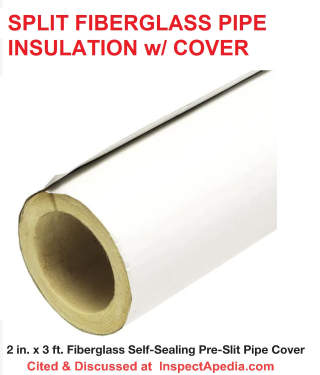
Above: split fiberglass pipe covering.
Below: a larger diameter split fiberglass insulating product used on larger pipes or on HVAC air ducts.
...
Identify Foil faced Foam Wrap-around Pipe Insulation, self-adhesive

Illustrated above, this pipe wrap is self-adhesive.
...
Below: plain foam tape self-adhesive wrap-around pipe insulation.
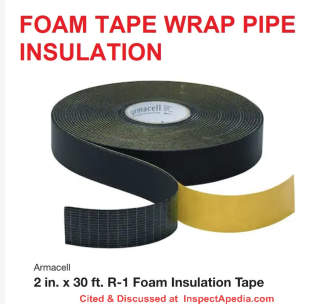
Illustrated above.
...
Identify Mineral Wool Pipe Insulation
Illustrated above.
Excerpting from GLT Products' description given in detail below:
Mineral wool fabricated pipe and fittings insulation is made from felted mineral wool bonded with a high temperature binder.
The resulting product is precisely fabricated to fit NPS and tube sizes for both commercial and industrial applications. The temperature range is from -20ºF (-29ºC) to 1200ºF (649ºC).
See details at
- MINERAL WOOL - ROCK WOOL INSULATION
- MINERAL WOOL PIPE INSULATION PRODUCT DATA SHEET [PDF] GLT Products, SPI Corporate Headquarters
2101 Rexford Road, Ste 300E
Charlotte, NC 28211 USA Tel: 704.336.9555 Tel: 1-800-874-1748. retrieved 2023/07/27, original source: gltproducts.com/user/general_pdfs/21091/pdfae48.pdf?t=1595346345
Website excerpt:
GLT Products is a ... manufacturer and producer of products that are used in both the industrial and commercial insulation markets. Founded in 1956 under the originating title of Great Lakes Textiles, ... GLT was acquired by SPI in May 2021.
...
Identify Older Pipe Wraps & Insulating Materials (including Asbestos)
Watch out: Asbestos pipe insulation is not in contemporary use and may be hazardous if disturbed. See details
Putty type wrap-on stick-on pipe insulating products - below, courtesy of InspectApedia readers John & Lee.
This pipe wrap is a sticky, putty-like material that sticks to itself and to the pipe and may be black, gray, or white in colour.
Watch out: Some older versions of this pipe insulation might contain asbestos [not verified - Ed.]. Treat it as non-friable ACM or have a sample tested.
This insulation is discussed in detail at ASBESTOS PIPE INSULATION
Magnesia Carbonate Pipe Insulation - illustrated below.
Magnesia carbonate insulation as well as the uncertain pipe insulation shown just below are discussed in detail
at MAGNESIUM CARBONATE ASBESTOS PIPE INSULATION
Below: unidentified pipe insulation, appearing to include a combination of materials.
This product is discussed in detail at ASBESTOS PIPE INSULATION
...
Guesses at Unidentified Pipe Insulation Products
On 2023-07-26 by Craig - what is this unidentified pipe cloth lagging material?
Home built 1960 - basement refinished at later date. Appears to be a cotton cloth coated with a yellow sealer over cold water pipes to prevent condensation above ceiling tiles.I don't think it is asbestos, but would like another opinion.
The white cloth is soft to the touch where not covered with the yellow paint/sealer. I understand positive/negative confirmation is not possible based on image alone, your opinion on likelihood is appreciated. Thank you.
This Q&A were posted originally
On 2023-07-27 by InspectApedia Publisher (mod) - white fabric, cotton or painted jute or something else?
@Craig, I agree that that pipe wrap looks like a painted cotton or maybe jute fabric but honestly I can't be certain from just the photo. Where is the building?
On 2023-07-27 by Craig
@InspectApedia Publisher, Thank you!
On 2023-07-25 by Jarvin - what is this wrapping material around a wooden strut - a bandage? Asbestos?
Hi, I know this isn't a pipe but I thought this was probably still the best place to ask!
I have this wrap around a single wooden roof strut in my attic space. I can't think why you would insulate a strut, but it struck me that it looked a little like it could be some sort of wrap insulation.
The property was renovated in the 1970s. It looks like a bandage to me, but I was concerned it could be some sort of ACM.
What do you think? Thanks in advance.
This Q&A were posted originally
On 2023-07-25 by InspectApedia Publisher (mod) - elastic bandage wrapped around a trip hazard?
@Jarvin,
I agree that the material in your photo looks like an elastic bandage - not something that would be an asbestos insulation product.
I would unwrap it from the wooden member - post another photo of what you see.
Perhaps it was put there to buffer impact after someone bumped their shin, or perhaps simply wrapped by a child.
Let's see what you find.
...
Continue reading at PIPE FREEZE PROTECTION or select a topic from the closely-related articles below, or see the complete ARTICLE INDEX.
Or see these
Recommended Articles
- ASBESTOS PIPE INSULATION
- CONDENSATE DRAIN INSULATION REQUIREMENTS
- DRAIN FREEZE PROTECTION
- FIRE-BLOCK FIRE RETARDANT FOAM SPRAY BUILDING INSULATION - at pipe penetrations in walls, floors, ceilings
- INSULATION CHOICES & PROPERTIES
- INSULATION IDENTIFICATION GUIDE
- INSULATION R-VALUES & PROPERTIES
- PIPE FREEZE PROTECTION - home
- PIPE FREEZE PROTECTION CABLE ASSEMBLY - heat tapes
- PIPE FREEZE-UP POINTS - where is freeze risk greatest
- PIPE INSULATION CHOICES, MATERIALS, TYPES
- REFRIGERANT PIPING INSULATION
- SWEATING (CONDENSATION) on PIPES, TANKS
- WATER PIPE FREEZE PROTECTION
Suggested citation for this web page
INSULATION to AVOID FROZEN PIPES at InspectApedia.com - online encyclopedia of building & environmental inspection, testing, diagnosis, repair, & problem prevention advice.
Or see this
INDEX to RELATED ARTICLES: ARTICLE INDEX to BUILDING FREEZE PROTECTION
Or use the SEARCH BOX found below to Ask a Question or Search InspectApedia
Ask a Question or Search InspectApedia
Try the search box just below, or if you prefer, post a question or comment in the Comments box below and we will respond promptly.
Search the InspectApedia website
Note: appearance of your Comment below may be delayed: if your comment contains an image, photograph, web link, or text that looks to the software as if it might be a web link, your posting will appear after it has been approved by a moderator. Apologies for the delay.
Only one image can be added per comment but you can post as many comments, and therefore images, as you like.
You will not receive a notification when a response to your question has been posted.
Please bookmark this page to make it easy for you to check back for our response.
IF above you see "Comment Form is loading comments..." then COMMENT BOX - countable.ca / bawkbox.com IS NOT WORKING.
In any case you are welcome to send an email directly to us at InspectApedia.com at editor@inspectApedia.com
We'll reply to you directly. Please help us help you by noting, in your email, the URL of the InspectApedia page where you wanted to comment.
Citations & References
In addition to any citations in the article above, a full list is available on request.
- [1] "New Electric Heat Tapes Help Prevent Fires," US Consumer Product Safety Commission (CPSC) #00936
- Mark Cramer Inspection Services Mark Cramer, Tampa Florida, Mr. Cramer is a past president of ASHI, the American Society of Home Inspectors and is a Florida home inspector and home inspection educator. Mr. Cramer serves on the ASHI Home Inspection Standards. Contact Mark Cramer at: 727-595-4211 mark@BestTampaInspector.com
- John Cranor [Website: /www.house-whisperer.com ] is an ASHI member and a home inspector (The House Whisperer) is located in Glen Allen, VA 23060. He is also a contributor to InspectApedia.com in several technical areas such as plumbing and appliances (dryer vents). Contact Mr. Cranor at 804-873-8534 or by Email: johncranor@verizon.net
- [5] "Freezeproof Your House," Mike McClintock, Rodale's New Shelter, p. 30, October 1985 (approximate date)
- [6] "How to Winterize Your Pipes," Mike McClintock, Homeowners How-To Magazine, p. 59-62, Nov-Dec 1979.
- [7] "HUD Regulation for Manufactured Homes; Requirement that Heat-Tape not include a GFCI [ copy on file as /plumbing/GFCI_Heat_Tapes_HUD_CPSC_Letter1994.pdf ] - ", Meeting Log, US CPSC, HUD, Dennis McCoskrie, ESEE, 2/14/1994
- [8] Thanks to reader Ryan T. Duffy for discussing the suggestion for GFCI's on heat tape circuits to reduce fire risk, October 2010.
- [9] Easy Heat heating cables, "Easy Heat AHB-013 Cold Weather Valve and Pipe Heating Cable",
http://www.emersonindustrial.com/, retrieved 3/2/2013,
Product Description: Temperature-controlled cable runs straight along pipe and valves, held in place by application tape and plugs into grounded electrical outlet. Keeps water flowing down to -380. For odd lengths of pipe over 3/4 inches in diameter, we recommend two separate cables on opposite sides of the pipe with up to 3 feet of overrun at center of pipe run. Metal pipe requires 1/2-inch fiberglass insulation around cable. For plastic pipe, its recommended wrapping pipe with aluminum foil before cable installation. The traditional resistance cable produces a fixed amount of heat based on the electrical line feed. It comes with a built-in thermostat that switches the flow of electricity on and off based on temperature. Cable installs fast and easy. Each package contains grounded plug, built in thermostat and instructions. Cable has weather resistant PVC outer jacket and inner insulation. Keeps water flowing down to 40 F. - [10] Easy Heat, "Easy Heat® Freeze Free® Preset Thermostat (EH-38)" , EGS Electrical Group, 9377 W. Higgins Rd.
Rosemont, IL 60018, USA or EGS Electrical Group, 99 Union Street
Elmira, ON N3B 3L7, Canada. Tel: 800.621.1506,
Product specifications: 15 amps, 120 volts 1800 watts Thermostat for use with Freeze Free Self-Regulating pipe heating cable, For dry location only, UL listed, CSA certified - In addition to citations & references found in this article, see the research citations given at the end of the related articles found at our suggested
CONTINUE READING or RECOMMENDED ARTICLES.
- Carson, Dunlop & Associates Ltd., 120 Carlton Street Suite 407, Toronto ON M5A 4K2. Tel: (416) 964-9415 1-800-268-7070 Email: info@carsondunlop.com. Alan Carson is a past president of ASHI, the American Society of Home Inspectors.
Thanks to Alan Carson and Bob Dunlop, for permission for InspectAPedia to use text excerpts from The HOME REFERENCE BOOK - the Encyclopedia of Homes and to use illustrations from The ILLUSTRATED HOME .
Carson Dunlop Associates provides extensive home inspection education and report writing material. In gratitude we provide links to tsome Carson Dunlop Associates products and services.


